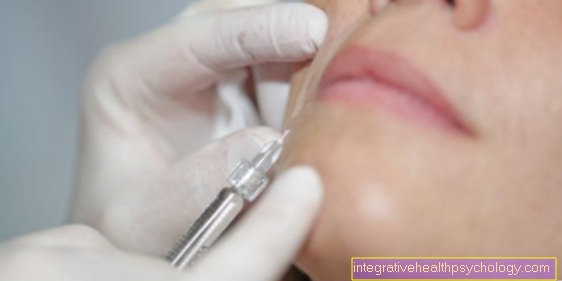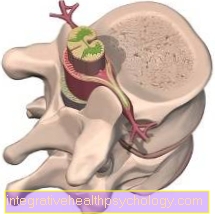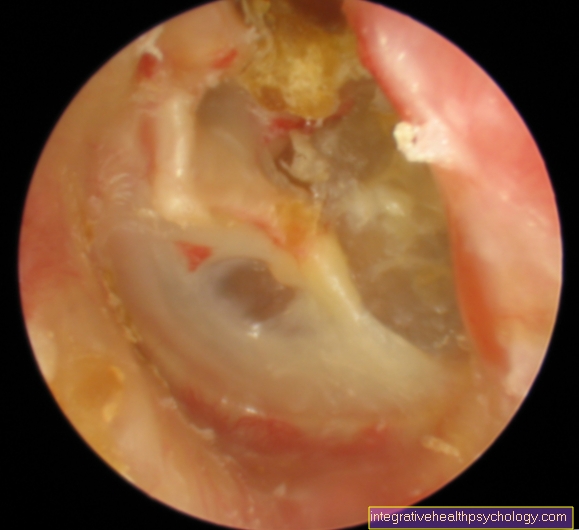Amoxicillin / clavulanic acid
definition
As a result of the frequent prescription of antibiotics in recent decades, bacteria have increasingly developed resistance to the individual active substances. Studies have shown that antibiotics are prescribed in around 60% of common colds, although only 5% of these diseases are caused by bacteria. In addition, antibiotics are also used in animal husbandry, which means that humans ingest them indirectly through animal meat.
In order to be able to continue to guarantee the effectiveness of the classic antibiotics, further drugs were developed to counteract the developed resistance mechanisms of the bacteria. An example of this is clavulanic acid, which inhibits a bacterial enzyme that breaks down various antibiotics. By combining clavulanic acid with penicillins, the various penicillins can continue to act against a wide range of bacteria.

Trade names
A widely used combination is amoxicillin (penicillin) with clavulanic acid. The combination product is available in Germany from various manufacturers under the names Amoxiclav, Amoclav and Augmentan. In Austria the trade names are Xiclav, Augmentin and Clavamox. In Switzerland, the products are available as Aziclav, Augmentin and Co-Amoxicillin.
How do the two active ingredients work?
Amoxicillin belongs to the group of penicillins. Due to the same effectiveness and a similar structure as cephalosporins, carbapenems and monobactams, the penicillins belong to the drug family of β-lactam antibiotics.
These antibiotics inhibit the cell wall formation of the bacteria. As a result, the bacteria can no longer multiply. At the same time, damage in the cell wall makes the bacterium unstable and dies. One speaks of a bactericidal (bactericidal) effect.
To protect themselves from the β-lactam antibiotics, many bacteria have developed an enzyme over time that splits and inactivates these antibiotics: the bacterial β-lactamase. This makes them resistant to a wide range of antibiotics. To avoid this resistance, the clavulanic acid was developed. Clavulanic acid is one of the so-called beta-lactamase inhibitors. Due to a similar structure to the β-lactam antibiotics, the bacterial β-lactamase also binds to the clavulanic acid and is inactivated by it. As a result, the antibiotics administered in combination (including amoxicillin) can again work against the bacteria.
Indications
The combination of amoxicillin and clavulanic acid is used in bacterial infections. The drug is effective against a wide range of bacteria. Often these are diseases of the ear, nose and throat area. Amoxicillin can be used to treat bacterial tonsillitis. To do this, however, a reliable diagnosis of a bacterial infection is urgently required before drug treatment. In addition, amoxicillin is also used for bacterial infections of the middle ear and sinuses. Also at
The combination of amoxicillin and clavulanic acid can be used to treat inflammation of the respiratory tract (upper and lower) as well as inflammation in the area of the lungs (pneumonia, bronchitis) and the lower urinary tract.
Read more on this topic at: Cystitis or kidney disease
The combination can also be used for infections in the skin and soft tissues. For bite injuries and infections of deep wounds, the combination of amoxicillin and clavulanic acid is the first choice.
Dosage of amoxicillin and clavulanic acid
Amoxicillin is usually given in the form of tablets. Suspensions and juices are also available for children, but some of them only have a limited effect. A common film-coated tablet contains 875 mg amoxicillin and 125 mg clavulanic acid. This tablet should usually be taken twice a day. In particularly severe cases, it can also be taken three times in one day.
The use and dosage of amoxicillin in children should be discussed with the attending physician. If possible, a suspension or dry juice should be used.
The dose must be adjusted by a doctor in patients with impaired kidney or liver function. Overall, the preparation should not be taken for more than 2 weeks. If the symptoms have not improved after this period, the next steps must be discussed with the attending physician. In the event of an overdose, stomach problems (nausea, vomiting, diarrhea) and seizures can occur. In this case, a doctor should be consulted immediately!
Further information on this topic can be found at: Amoxicillin dosage
Side effect of amoxicillin and clavulanic acid
If you are known to be hypersensitive to penicillins, you should refrain from taking amoxicillin in any case! There is a risk of life-threatening shock. There is also an increased risk of hypersensitivity reactions in patients with known severe allergies or bronchial asthma. In this case, the therapy should be closely monitored by a doctor or, if possible, a different preparation should be used.
A common side effect of administering amoxicillin with clavulanic acid is the occurrence of allergic reactions. Typically, itchy rashes appear. Especially with simultaneous viral infection with glandular fever or known chronic lymphocytic leukemia (CLL), there is a risk of a large skin rash (the so-called amoxicillin rash).
Read more at: Amoxicillin rash and amoxicillin itching
In addition, complaints in the gastrointestinal tract are possible. Patients often complain of nausea, vomiting, and loss of appetite. Flatulence and diarrhea are also possible.
Amoxicillin and alcohol - are they compatible?
If possible, alcohol should be avoided while taking antibiotics. During a bacterial infection, the human body is severely affected and needs rest and relaxation. Instead, the body becomes stressed and weakened by consuming alcohol.
In addition, there are often interactions between alcohol and various antibiotics.Only a small part of amoxicillin is metabolized and excreted in the liver. However, since both alcohol and clavulanic acid are broken down by the liver, they can influence each other's breakdown. Increased concentrations of the two substances in the blood, sometimes with considerable side effects, are possible. At the same time, the effect of the antibiotic can be completely canceled out. In addition, the heavy burden on the liver's metabolism can lead to significant damage to the liver. In these cases, acutely life-threatening conditions can arise, particularly in patients with known liver or kidney damage.
You can find more information at: Amoxicillin and alcohol
Amoxicillin in pregnancy
If possible, treatment with amoxicillin and clavulanic acid should be avoided during pregnancy for safety reasons. The combination of active ingredients can enter the baby's bloodstream via the placenta. However, if therapy is unavoidable, it should be expressly ordered by a doctor and checked regularly. There are no better proven alternatives to antibacterial treatment during pregnancy.
Various studies and investigations have so far not been able to prove any harmful effects of the drug on the unborn child. Especially in the first two thirds of pregnancy, no effect of the drug on the baby could be proven. In very rare individual cases, however, the baby's bowel inflammation was sometimes severe when the drug was used shortly before birth.
Read more at: Antibiotics in Pregnancy





























